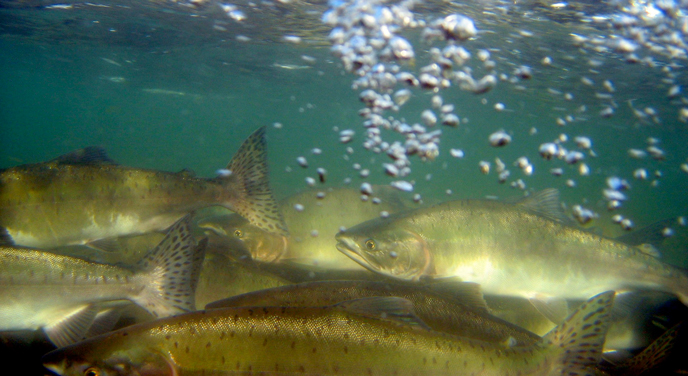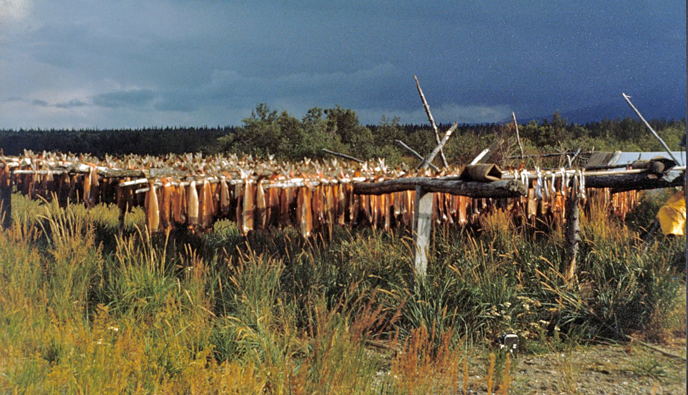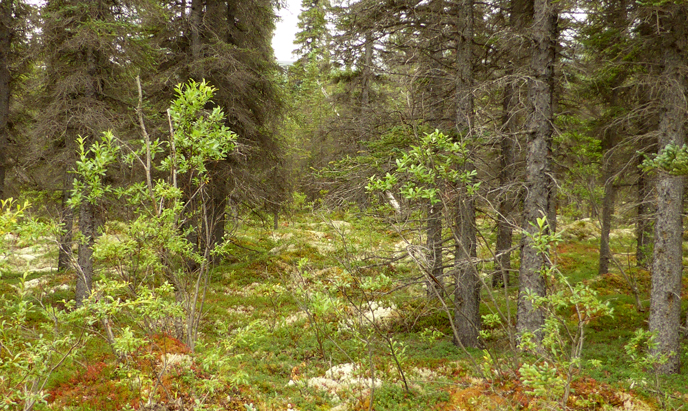
The Bristol Bay region is some of the largest runs of Pacific salmon in the world. Salmon are the keystone species of Katmai National Park. The Brooks Camp area and Katmai in general would not be what it is today without sockeye salmon. Everything present has been built on salmon and their annual migration from vast oceans to Katmai.
People have settled in places with high densities of food throughout history. Native Alaskans lived inside what is now the park boundary for over 9000 years. They settled in the Brooks Camp area for the past 4500 years. In the distant past the water levels of the various lakes in Katmai were much higher than in present times. Settlements shifted with changing rivers and lake shores. Over time the water dropped to such an extent that Naknek Lake and Lake Brooks became separate bodies of water connected by the Brooks River. Brooks Falls appeared and became a stumbling block for sockeye migrating upriver to their spawning grounds. Native people found a food source that was so productive that in just a few weeks in the summer, they could gather enough food to last them through the long Alaskan winter. They took advantage of the millions of migrating fish gathering in Naknek Lake and then swimming up the Brooks River. Hundreds upon hundreds of pounds of salmon flesh was stored and then consumed during the winter ensuring the survival of the native people who were only forced to leave their ancestral homes with the eruption of Novarupta on June 6, 1912.

Harvested salmon are eaten fresh or air dried for long term storage. (NPS Photo)
In addition to providing subsistence to the native Alaskans, salmon also provide for the plant life in the park. As the salmon spawn and begin to die their carcasses decompose and fertilize the soil of the river banks and boreal forests. The verdant grasses, flowers, and trees in the park are all recipients of this yearly influx of new nutrients. The plants then pass along the energy they have gained to the many herbivores and omnivores. Animals that may have no interactions with salmon end up depending on the salmon in order to live and thrive in this area.

Salmon annually fertilize plants growing along salmon streams, increasing plants' growth and productivity (NPS/M. Fitz)
The most obvious users of the extensive salmon runs in the park are the resident brown bears. One question visitors pose over and over again is “What is the difference between a brown bear and a grizzly bear?” Taxonomically speaking, they are the same species Ursus arctos. The long answer is grizzly bears live in the interior sections of Alaska, Canada, and the Lower 48 while brown bears are coastal creatures who gain many of their calories from rich marine sources—mostly salmon in Katmai. A pre-spawn salmon contains around 4500 calories. That’s the equivalent of nine McDonald’s cheeseburgers. The bears fish the streams, rivers, and lakes in the park to eat as many of the prize fish as possible to pack on weight for their winter hibernation. If there were no salmon, Katmai would be home to many fewer bears, and the bears who call this place home would be much smaller in nature than the current population. Migrating salmon are an easy meal for the bears of Katmai, and they take advantage of the bounty that is presented to them every summer.
Without salmon there would be far fewer archaeological sites, plants, and bears to be found in Katmai. Everything connects through salmon. The iconic deep green head and brilliant red body of the sockeye is the key building block of Katmai National Park.
